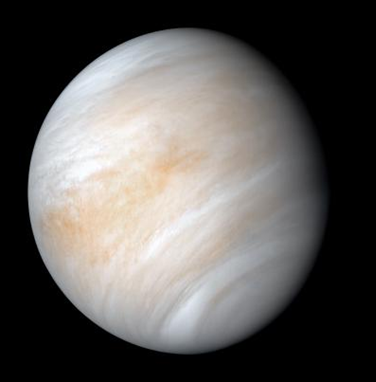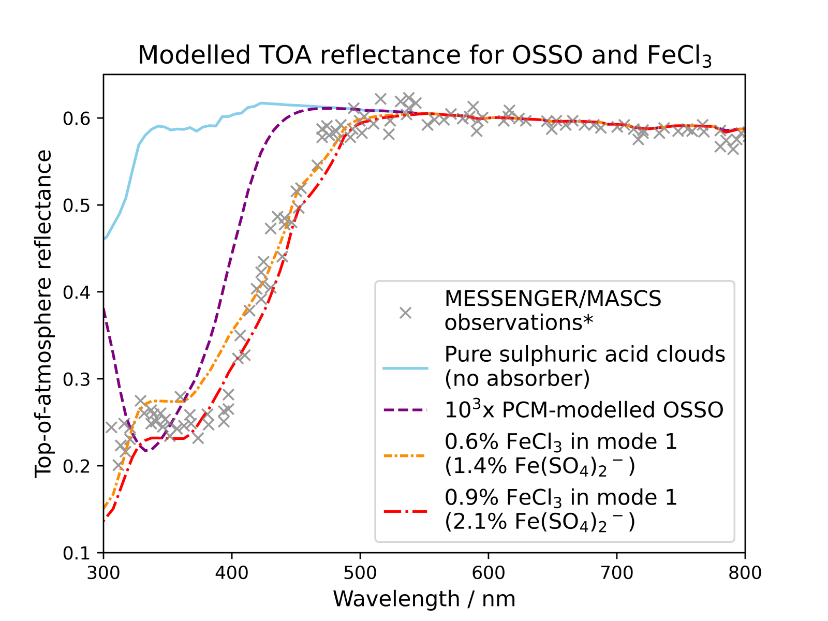Investigation of potential candidates for the Venusian unknown UV absorber: FeCl3 and OSSO
- 1University of Leeds, School of Chemistry, Leeds, United Kingdom of Great Britain – England, Scotland, Wales (pmjve@leeds.ac.uk)
- 2National Centre for Atmospheric Science, University of Leeds, Leeds, UK
- 3Met Office, Fitzroy Road, Exeter, UK
- 4School of Physics and Astronomy, University of Leeds, Leeds, UK
Understanding the composition and distribution of the unknown UV absorber (Figure 1) in the Venusian atmosphere has been an open question in planetary science for close to 100 years. Many candidates for the absorber have been proposed over the years. We focus on two possibilities: ferric chloride (FeCl3)[1] and the cis- and trans- forms of the SO dimer (OSSO)[2].

Figure 1: A false colour image of Venus. Regions of UV absorption appear orange. The cause of this absorption is unknown. Image credit: NASA/JPL-Caltech.
FeCl3 has been proposed to exist within the sulphuric acid cloud droplets, but the absorption spectrum of FeCl3 generally used in the literature was measured in ethyl acetate, which is not present on Venus and produces an absorption spectrum with little similarity to the Venusian absorber[3]. We have measured the absorption spectrum of FeCl3 in sulphuric acid with small quantities of HCl added, and we found that it is much more similar in shape to the observed spectrum of the unknown absorber than prior FeCl3 spectra available in the literature.
The spectra measured in sulphuric acid contain contributions from both ferric chloride and ferric sulphate ions. We estimated the molar partitioning of the species in the mixtures by performing least squared fitting to reproduce each measured spectrum from spectra of pure ferric sulphate (measured for Fe2(SO4)3 in 75-87 wt% aqueous H2SO4) and pure ferric chloride (measured for FeCl3 in 5-37 wt% aqueous HCl). We estimated the rate of the reaction converting FeCl3 toward Fe2(SO4)3 using this method at several temperatures and extrapolate to Venusian temperatures to predict the lifetime of FeCl3 within the sulphuric acid cloud droplets.
To test if either FeCl3 or OSSO are viable candidates we employ three models: the global Planetary Climate Model for Venus (PCM-Venus) to model the photochemistry and 3D transport of the candidates in the atmosphere[4], a 1D sectional aerosol model to predict agglomeration and sedimentation as a transport mechanism of FeCl3 particles[5], and the 1D multiple scattering radiative transfer model SOCRATES[6].
We have added iron chemistry and updated sulphur chemistry into PCM-Venus in order to predict the abundance of gas-phase FeCl3 produced by the reaction of gas-phase HCl with iron produced by the ablation of cosmic dust particles around 115 km, and of OSSO produced from the recombination of two SO molecules. Mean gas and dynamical profiles from the PCM are used to initialise the agglomeration and sedimentation model, which is then run for many Venus years to reach steady state.
The potential contributions of each species to the observed absorption were assessed using SOCRATES to predict the observed absorption from instantaneous dayside PCM-modelled concentrations of OSSO, and to estimate the required concentrations of FeCl3 in the different cloud modes and the required increase of OSSO from the PCM results to fully explain the absorption measured by MESSENGER/MASCS during its June 2007 Venus flyby (Pérez-Hoyos et al., 2018).
Agglomeration and sedimentation modelling of FeCl3 suggests that the PCM-modelled FeCl3 column abundance above 60 km can account for more than 40% of the observed absorption. The full absorption can be explained by approximately 1 wt% FeCl3 in the mode 1 cloud droplets (Figure 2). Large ferric sulphate ion concentrations in the laboratory spectra used to model the absorption lead to higher than observed absorption near 300 nm. Work is ongoing to correct the iron partitioning between chloride and sulphate to expected Venusian ratios.
Results of SOCRATES modelling suggest that an OSSO concentration profile 103 x larger than the PCM-modelled profile would be required to reproduce the depth of the observed absorption (Figure 2). The SO2 and SO profiles at 60 - 80km in the PCM are currently ~100 x smaller than observed concentrations, and so increase of 103 from current concentrations is not unreasonable (as OSSO rate of formation will increase with the square of SO concentration). However, the agreement of the spectral shape with the observations is significantly worse than has been previously reported by Frandsen et al. (2016)[2]. The spectral shape is better approximated when the concentration of trans-OSSO is increased relative to the cis-OSSO, though we have found no chemical justification to make this adjustment.

Figure 2: Preliminary data comparing the MESSENGER/MASCS spectrum of the unknown absorber (*[3], grey crosses) to SOCRATES-modelled concentrations that best reproduce the depth of the absorption for cis- and trans-OSSO (purple dashed line) and FeCl3 in mode 1 (modal radius = 0.2 µm) sulphuric acid cloud droplets (orange and red dash-dotted lines). The modelled spectrum with neither OSSO or FeCl3 included (blue solid line) is included for reference.
We conclude that both candidates show some merit as the unknown absorber and a mixture of both species is likely present on Venus and contributing to the absorption. Work is ongoing to decrease the ferric sulphate contribution in the laboratory-measured FeCl3 spectrum in line with expected Venusian concentrations (and thereby decrease the high absorption near 300 nm seen in current FeCl3 spectra shown in Figure 2), and to reproduce observed SO2 and SO concentrations with PCM-Venus, thereby likely increasing OSSO modelled concentrations.
References
[1] Zasova et al., 1981, https://doi.org/10.1016/0273-1177(81)90213-1
[2] Frandsen et al. 2016, https://doi.org/10.1002/2016GL070916
[3] Pérez-Hoyos et al. 2018, https://doi.org/10.1002/2017JE005406
[4] Martinez et al. (2024), doi.org/10.1016/j.icarus.2024.116035
[5] Frankland et al., 2017, https://doi.org/10.1016/j.icarus.2017.06.005
[6] Manners et al. (2022), SOCRATES Technical Guide, available at: https://code.metoffice.gov.uk/trac/socrates
How to cite: Egan, J., Feng, W., James, A., Manners, J., Marsh, D., and Plane, J.: Investigation of potential candidates for the Venusian unknown UV absorber: FeCl3 and OSSO , Europlanet Science Congress 2024, Berlin, Germany, 8–13 Sep 2024, EPSC2024-971, https://doi.org/10.5194/epsc2024-971, 2024.